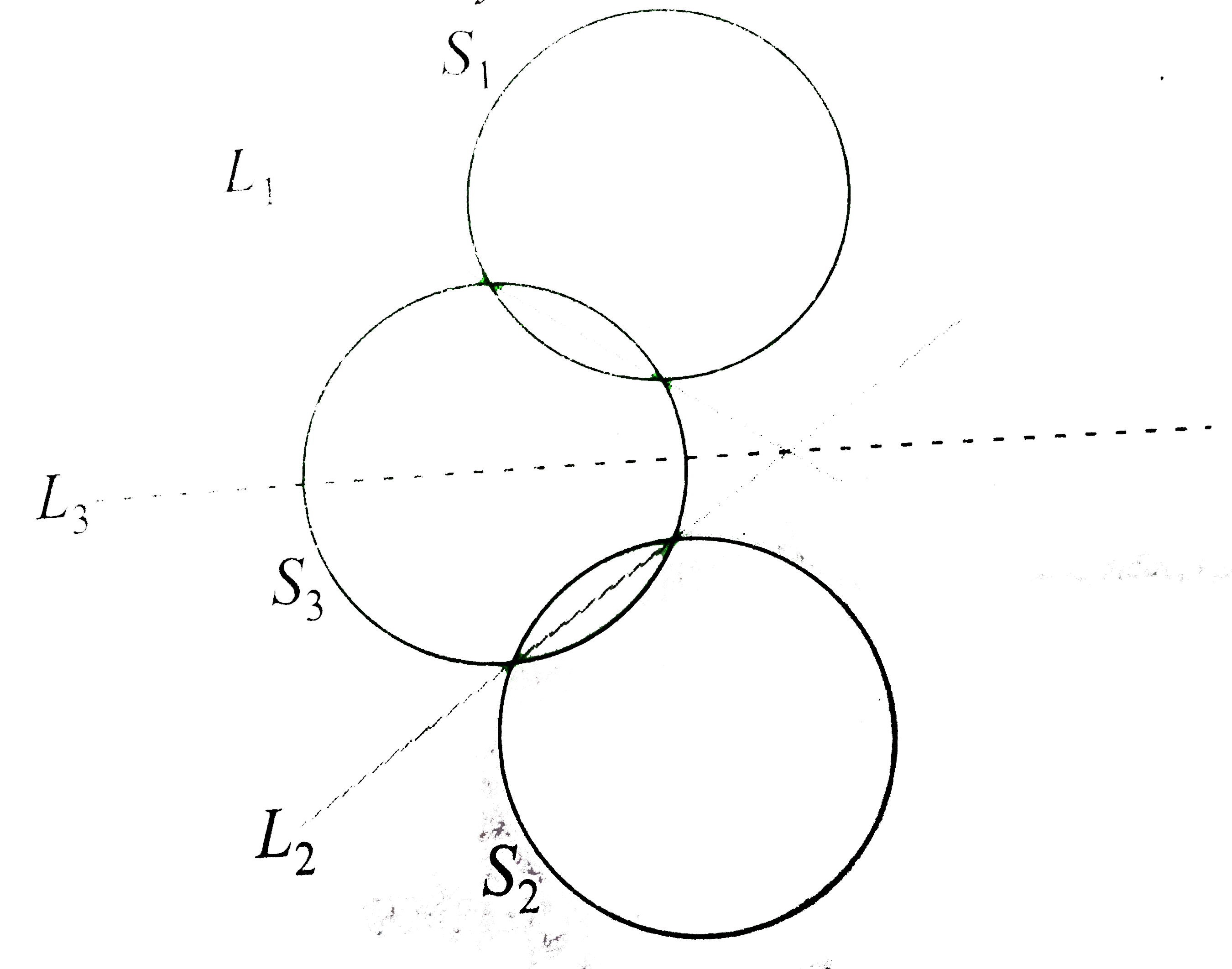The line Ax+By+C=0 cuts the circle x2+y2+ax+by+c=0 at PandQ . The line A′x+B′x+C′=0 cuts the circle x2+y2+a′x+b′y+c′=0 at RandS. If P,Q,R, and S are concyclic, then show that |a−a'b−b'c−c'ABCA'B'C'|=0Solution in Tamil
P and Q are the points of intersection of the line
L1≡Ax+By+C=0 (1)
and the circle
S1≡x2+y2+ax+by+c=0 (2)
R and S are the ponits of intersection of the line
L2≡A'x+B'y+C'=0 (3)
and the circle
S2≡x2+y2+a'x+b'y+c'=0 (4)

The radical axis of the circles S1= and S2= is
S1−S2=0
i.e., L3≡(a−a')x+(b−b')y+(c−c')=0 (5)
If P,Q,R, and S are concyclic and S3= is the equation of this circle thorugh P,Q,R, and S, line (1) is the radical axis of the circle S1=0 and S3=0 and line (2) is the radical axis of the circles S2 and S3=0.
Thus, the straight line gives by (5),(1), and (3) are the radical axsed of the circles S1=0,S2=0 and S3=0 taken in pairs. Since the radical axes of the three circles taken in pairs concurrent or parrallel, we have
∣∣
∣∣a−a'b−b'c−c'ABCA'B'C'∣∣
∣∣=0
Topper's Solved these Questions
Similar Questions
If a circle whose center is (1,−3) touches the line 3x−4y−5=0 , then find its radius.
View SolutionFind the radius of the circle (x−5)(x−1)+(y−7)(y−4)=0 .
View SolutionConsider a G.P. with first term (1+x)n, |x|<1, common ratio 1+x2 and number of terms (n+1). Let 'S' be sum of all the terms of the G.P., then
The coefficient of xn is 'S' is
View SolutionIf ax+by=10 is the chord of minimum length of the circle (x−10)2+(y−20)2=729 and the chord passes through (5,15) then the value of (4a+2b) is
View SolutionIf the abscissae and the ordinates of two point AandB be the roots of x2+2ax−b2a n d x2+2px−q2=0 respectively, show that the equation of the circle described on AB as diameter is x2+y2+2ax+2py−b2−q2=0
View SolutionThe determinant ∣∣y2−xyx2abca'b'c'∣∣ is equal to a.∣∣bx+aycx+byb′x+a'yc′x+b'y∣∣ b. ∣∣ax+bybx+cya′x+b'yb'x+c'y∣∣ c. ∣∣bx+cyax+byb′x+c'ya′x+b'y∣∣ d. ∣∣ax+bybx+cya′x+b'yb′x+c'y∣∣
View SolutionIf (ax2+c)y+(a′x2+c′)=0 and x is a rational function of y and ac is negative, then
a. ac′+c′c=0
b. a/a'=c/c'
c. a2+c2=a'2+c'2
d. aa′+cc′=1
View SolutionIf (ax2+bx+c)y+(a′x2+b′x2+c′)=0 and x is a rational function of y, then prove that (ac′−a′c)2=(ab′−a′b)×(bc′−b′c).
View SolutionThe determinant ∣∣y2−xyx2abca'b'c'∣∣ is equal to a.∣∣bx+aycx+byb′x+a'yc′x+b'y∣∣ b. ∣∣ax+bybx+cya′x+b'yb'x+c'y∣∣ c. ∣∣bx+cyax+byb′x+c'ya′x+b'y∣∣ d. ∣∣ax+bybx+cya′x+b'yb′x+c'y∣∣
View SolutionIf the quadrilateral formed by the lines ax+by+c=0,a′x+b′y+c=0,ax+by+c′=0,a′x+b′y+c′=0 has perpendicular diagonals, then (a) b2+c2=b'2+c'2 (b)c2+a2=c'2+a'2 (c)a2+b2=a'2+b'2 (d) none of these
View SolutionThe line Ax+By+C=0 cuts the circle x2+y2+ax+by+c=0 at PandQ . The line A′x+B′x+C′=0 cuts the circle x2+y2+a′x+b′y+c′=0 at RandS. If P,Q,R, and S are concyclic, then show that |a−a'b−b'c−c'ABCA'B'C'|=0
View SolutionIf the circles x2+y2+2a′x+2b′y+c′=0 and 2x2+2y2+2ax+2by+c=0 intersect othrogonally, then prove that aa′+bb'=c+c′2.
View SolutionIf the quadrilateral formed by the lines ax+by+c=0,a′x+b′y+c=0,ax+by+c′=0,a′x+b′y+c′=0 has perpendicular diagonals, then b2+c2=b'2+c'2 c2+a2=c'2+a'2 a2+b2=a'2+b'2 (d) none of these
View SolutionIf the abscissae and the ordinates of two point AandB be the roots of ax2+bx+c=0anda′y2+b′y=c′=0 respectively, show that the equation of the circle described on AB as diameter is aa′(x2+y2)+a′bx+ab′y+(ca′+ca)=0.
View SolutionIf the quadrilateral formed by the lines
ax+by+c=0,a′x+b′y+c=0
ax+by+c′=0,a′x+b′y+c′=0 have perpendicular diagonals, then
View SolutionThe two lines ax+by=c and a′x+b′y=c′ are perpendicular if
View Solution
